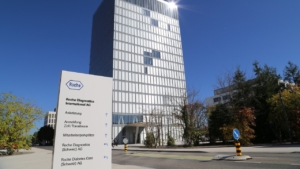
Giredestrant demonstrates efficacy in early-stage breast cancer
Roche has reported that its selective estrogen receptor degrader (SERD), giredestrant, has demonstrated significant clinical benefit in pivotal Phase III trials for adjuvant early-stage ER-positive, HER2-negative breast cancer, as well as strong efficacy in advanced breast cancer settings. These results position giredestrant as the first oral SERD to show meaningful clinical benefit in this indication. The announcement sparked a notable 7% jump in Roche’s share price in a single day.
Roche has reported positive Phase III data for its selective estrogen receptor degrader (SERD) giredestrant across multiple stages of breast cancer treatment. The company announced on November 18, 2025, that the drug significantly extended invasive disease-free survival compared with standard hormonal therapy in the adjuvant treatment of patients with early-stage, estrogen receptor-positive (ER-positive), HER2-negative breast cancer. The results come from the Phase III lidERA study, which enrolled over 4,100 patients with a medium to high risk of recurrence. This makes Giredestrant the first oral SERD to demonstrate a clinical benefit in this setting.
The study also showed a positive trend in overall survival, although the data are still immature. Giredestrant was well tolerated, with no unexpected safety findings reported. The full results are scheduled to be presented at a medical congress and will be submitted for regulatory approval. “Given that oestrogen receptor (ER)-positive breast cancer accounts for around 70 per cent of diagnosed cases, these findings – together with current data on advanced ER-positive breast cancer – suggest that giredestrant has the potential to improve treatment outcomes for many people with this condition,” said Roche’s CMO, Dr Levi Garraway.
Already at the ESMO Congress in mid-October, results from the Phase III evERA study were presented, in which Giredestrant was combined with the mTOR inhibitor Everolimus. This study evaluated patients with ER-positive, HER2-negative advanced breast cancer who frequently harbor ESR1 mutations following first-line hormonal therapy with CDK4/6 inhibitors. The combination of Giredestrant and Everolimus reduced the risk of progression by 62% in patients with ESR1 mutations, with a median progression-free survival (PFS) of 9.99 months compared to 5.45 months in the control group. In the overall population, the treatment reduced the risk of progression or death by 44%. In an exploratory analysis, patients without ESR1 mutations did not show a significant benefit compared with standard therapy. The combination prevents early progression often seen with monotherapies and surpasses the previous PFS threshold of approximately six months. Adverse events were largely consistent with the known safety profile of Everolimus.
Oral SERDs are considered potential successors to older injectable therapies. Roche faces competition from AstraZeneca, whose SERD studies are expected to report results in 2026 with stricter endpoints and longer treatment durations, as well as from Eli Lilly, which already markets a SERD (Inluriyo) and is expected to report additional data in 2027.
Giredestrant is being evaluated in five Phase III studies across early, locally advanced, and metastatic stages, including combinations with Everolimus, CDK4/6 inhibitors, and Phesgo. Roche sees the new data as an indication that Giredestrant could become a standard endocrine therapy in early-stage breast cancer. However, in the Phase II acelERA trial, giredestrant failed to demonstrate a statistically significant improvement in investigator-assessed progression-free survival (INV-PFS) in patients with ER-positive, HER2-negative advanced breast cancer who had received one or two prior systemic therapies. The study compared giredestrant with physician’s choice of endocrine monotherapy, such as fulvestrant or an aromatase inhibitor. Although INV-PFS showed a numerical trend in favour of giredestrant (HR 0.81, p = 0.176), this did not reach statistical significance. Subgroup analysis suggested a greater potential benefit in patients with ESR1 mutations (HR 0.60). Secondary endpoints, including clinical benefit rate (CBR 31.8 % vs 21.1 %) and objective response rate (ORR 12.6 % vs 7.2 %), also favoured giredestrant numerically. The drug was generally well tolerated, with a safety profile comparable to standard endocrine therapy. Overall survival data were immature at the time of analysis. While the trial did not meet its primary endpoint, the trends observed in ESR1-mutant tumours and the favourable safety profile provided a rationale for continued investigation in subsequent studies.Whether the drug will ultimately be adopted in clinical practice also depends on the outcomes of competing SERD programs.


 Roche Diagnostics International
Roche Diagnostics International PharmaMar SA
PharmaMar SA Henk Vrieselaar - stock.adobe.com
Henk Vrieselaar - stock.adobe.com